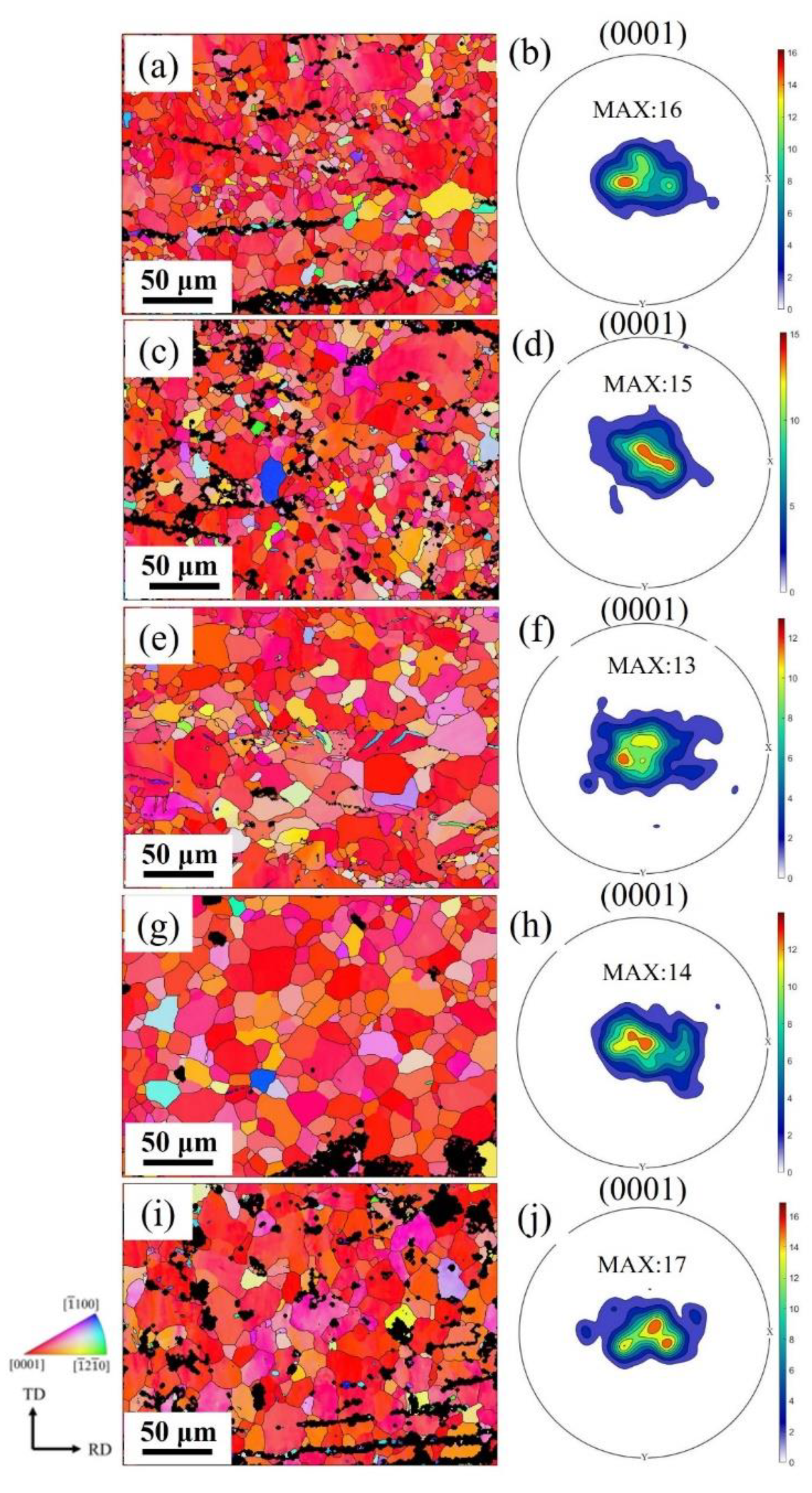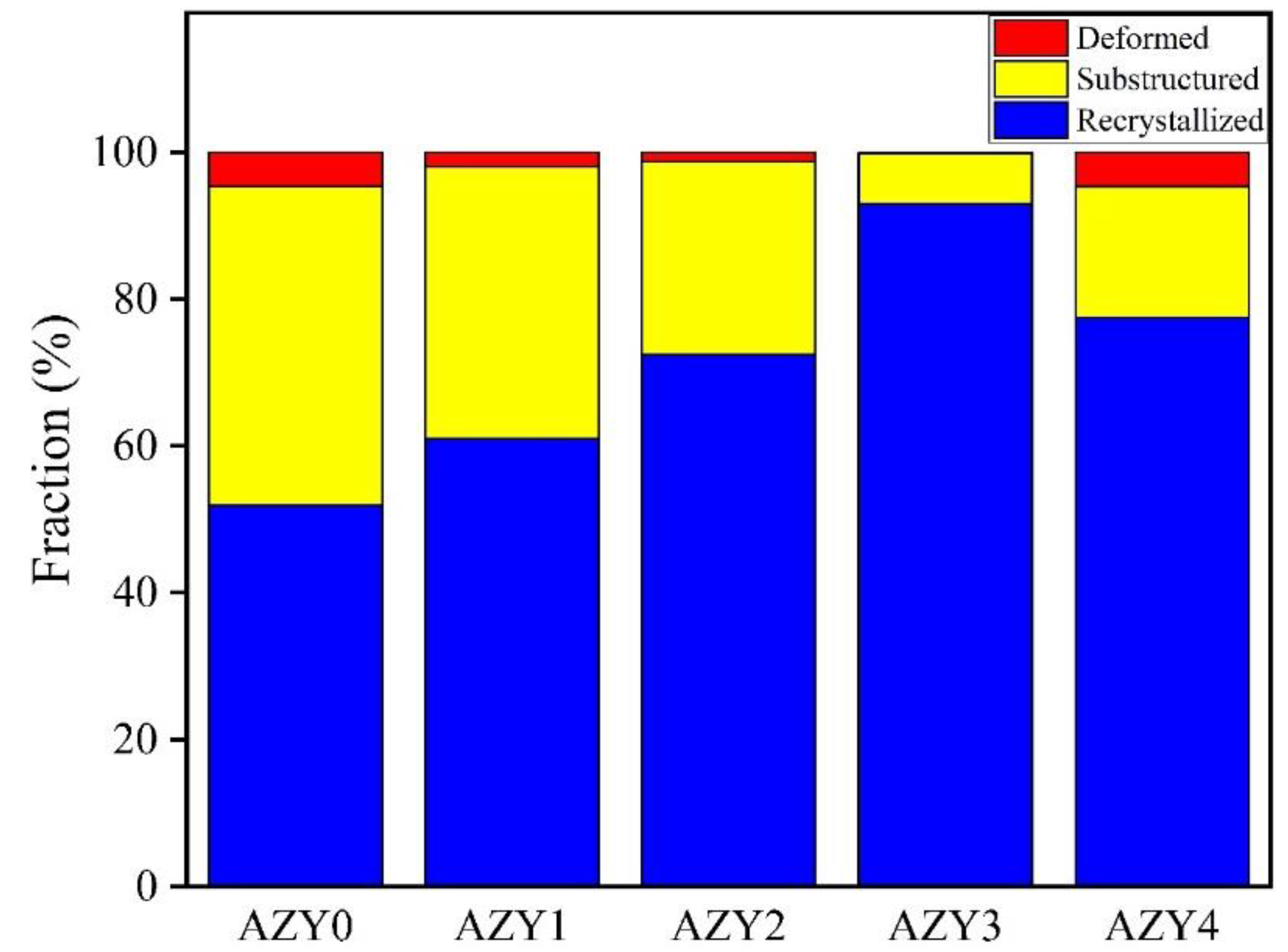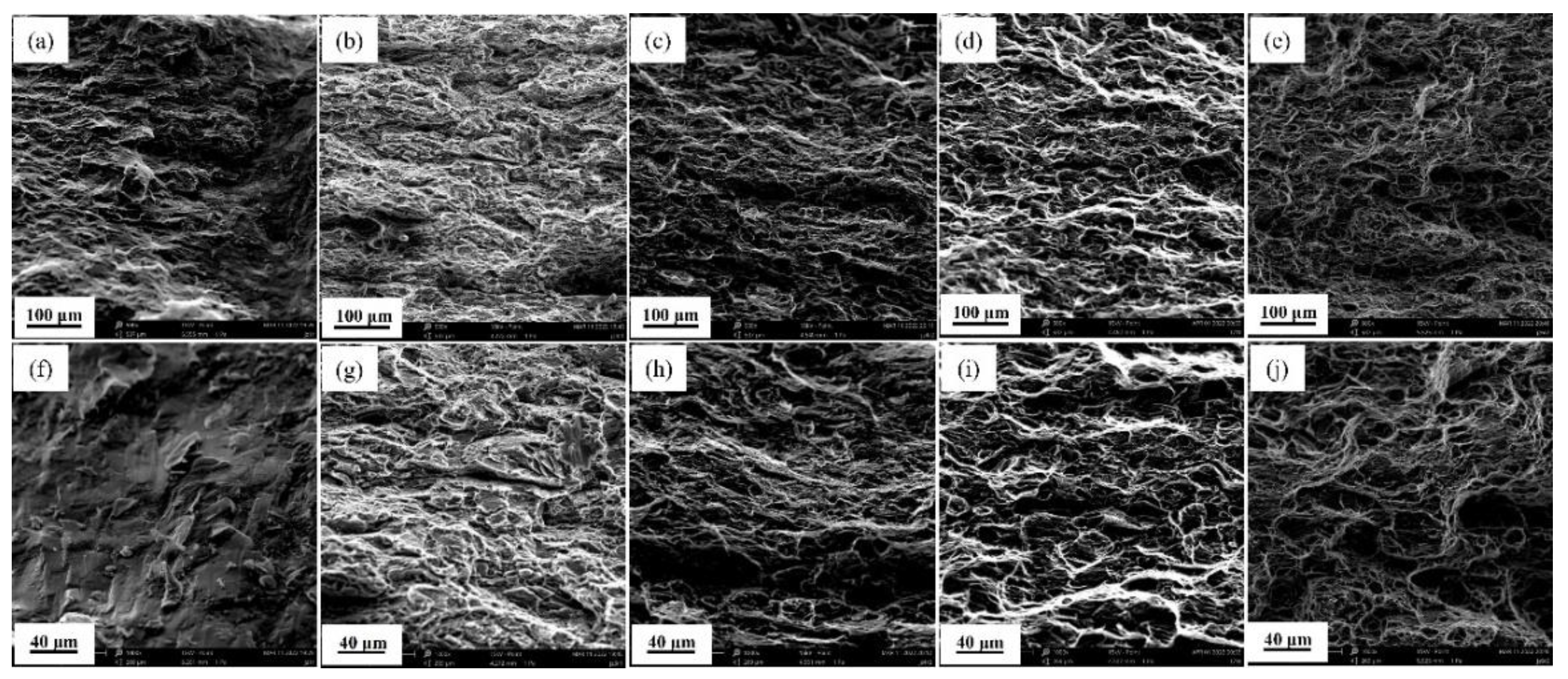Effect of Y Alloying on Microstructure and Mechanical Properties of AZ61 Magnesium Alloy Sheets Applied as 3C Electronic Product Shells
Abstract
:1. Introduction
2. Materials and Methods
3. Results
3.1. Microstructure
3.2. Mechanical Properties
4. Discussion
5. Conclusions
- (1)
- The addition of Y could form the Al2Y phase and effectively promoted the occurrence of recrystallization, so that many parallel or interlaced deformation grains in the AZ61 magnesium alloy sheet gradually changed into the equiaxed crystal structures and completed the macroplastic deformation of the alloy.
- (2)
- The addition of Y could weaken the texture and changed the texture type and made the concentrated grain orientation dispersed. The weakened bimodal texture improved the elongation significantly in 0.9 wt.% of the Y-modified AZ61 sheets.
- (3)
- The main precipitate phase of the Y-alloying AZ61 sheets was Al2Y. Due to the large consumption of the Mn and Al elements, there was no obvious large precipitation of the Al8Mn5 and Mg17Al12 phases. As a result, the plasticity of the sheets with 0.9 wt.% of Y could be significantly improved, and even the elongation could reach 18%. Meanwhile, the yield strength and tensile strength still kept a relative value, i.e., 186 MPa and 271 MPa, respectively.
Author Contributions
Funding
Data Availability Statement
Conflicts of Interest
References
- Jiang, B.; Yin, H.-M.; Li, R.-H.; Gao, L. Grain refinement and plastic formability of Mg-14Li-1Al alloy. Trans. Nonferrous Met. Soc. China 2010, 20, s503–s507. [Google Scholar] [CrossRef]
- Bian, M.; Huang, X.; Mabuchi, M.; Chino, Y. Compositional optimization of Mg–Zn–Sc sheet Alloy for enhanced room temperature stretch formability. J. Alloys Compd. 2020, 818, 152891. [Google Scholar] [CrossRef]
- Chaudry, U.M.; Kim, Y.S.; Hamad, K. Effect of Ca addition on the room-temperature formability of AZ31 magnesium alloy. Mater. Lett. 2019, 238, 305–308. [Google Scholar] [CrossRef]
- Nakata, T.; Xu, C.; Ohashi, H.; Yoshida, Y.; Kamado, S. New Mg–Al based alloy sheet with good room-temperature stretch formability and tensile properties. Scr. Mater. 2020, 180, 16–22. [Google Scholar] [CrossRef]
- Wu, D.; Chen, R.; Han, E. Excellent room-temperature ductility and formability of rolled Mg–Gd–Zn alloy sheets. J. Alloys Compd. 2011, 509, 2856–2863. [Google Scholar] [CrossRef]
- Chen, J.; Zhang, Q.; Li, Q. Microstructure and mechanical properties of AZ61 magnesium Alloys with the Y and Ca combined addition. Int. J. Met. 2018, 12, 897–905. [Google Scholar]
- Huang, X.; Suzuki, K.; Yuasa, M.; Chino, Y. Effects of initial microstructure on the microstructural evolution and stretch formability of warm rolled Mg–3Al–1Zn alloy sheets. Mater. Sci. Eng. A 2013, 587, 150–160. [Google Scholar] [CrossRef]
- Huang, X.; Suzuki, K.; Saito, N. Enhancement of stretch formability of Mg–3Al–1Zn alloy sheet using hot rolling at high temperatures up to 823K and subsequent warm rolling. Scr. Mater. 2009, 61, 445–448. [Google Scholar] [CrossRef]
- Tu, J.; Zhou, T.; Liu, L.; Shi, L.; Hu, L.; Song, D.; Song, B.; Yang, M.; Chen, Q.; Pan, F. Effect of rolling speeds on texture modification and mechanical properties of the AZ31 sheet by a combination of equal channel angular rolling and continuous bending at high temperature. J. Alloys Compd. 2018, 768, 598–607. [Google Scholar] [CrossRef]
- Martynenko, N.S.; Anisimova, N.Y.; Rybalchenko, O.V.; Kiselevskiy, M.V.; Rybalchenko, G.; Straumal, B.; Temralieva, D.; Mansharipova, A.T.; Kabiyeva, A.O.; Gabdullin, M.T.; et al. Rationale for Processing of a Mg-Zn-Ca Alloy by Equal-Channel Angular Pressing for Use in Biodegradable Implants for Osteoreconstruction. Crystals 2021, 11, 1381. [Google Scholar] [CrossRef]
- Huo, Q.; Yang, X.; Ma, J.; Sun, H.; Qin, J.; Jiang, Y. Microstructural and textural evolution of AZ61 magnesium alloy sheet during bidirectional cyclic bending. Mater. Charact. 2013, 79, 43–51. [Google Scholar] [CrossRef]
- Shan, Z.H.; Zhang, Y.X.; Wang, B.; Zhang, Q.; Fan, J. Microstructural evolution and precipitate behavior of an AZ61 alloy plate processed with ECAP and electropulsing treatment. J. Mater. Res. Technol. 2022, 19, 382–390. [Google Scholar] [CrossRef]
- Li, D.-W.; Wang, H.-Y.; Wei, D.-S.; Zhao, Z.-X.; Liu, Y. Effects of Deformation Texture and Grain Size on Corrosion Behavior of Mg–3Al–1Zn Alloy Sheets. ACS Omega 2020, 5, 1448–1456. [Google Scholar] [CrossRef] [PubMed]
- Wu, Y.; Zhu, R. Effect of Rolling Temperature on the Microstructure and Mechanical Properties of AZ31 Alloy Sheet Processed through Variable-Plane Rolling. J. Mater. Eng. Perform. 2019, 28, 6182–6191. [Google Scholar] [CrossRef]
- Wang, L.; Zhang, Z.; Cao, M.; Zhang, H.; Han, T.; Yang, Q.; Wang, H.; Cheng, W. Effect of pre-strain levels and high temperature annealing on the formability of AZ31 Mg alloy thin sheet during stretch deformation. Mater. Res. Express 2019, 6, 086595. [Google Scholar] [CrossRef]
- Wang, Q.; Shen, Y.; Jiang, B.; Tang, A.; Chai, Y.; Song, J.; Yang, T.; Huang, G.; Pan, F. A good balance between ductility and stretch formability of dilute Mg-Sn-Y sheet at room temperature. Mater. Sci. Eng. A 2018, 736, 404–416. [Google Scholar] [CrossRef]
- Shi, B.; Xiao, Y.; Shang, X.; Cheng, Y.; Yan, H.; Dong, Y.; Chen, A.; Fu, X.; Chen, R.; Ke, W. Achieving ultra-low planar anisotropy and high stretch formability in a Mg-1.1Zn-0.76Y-0.56Zr sheet by texture tailoring via final-pass heavy reduction rolling. Mater. Sci. Eng. A 2018, 746, 115–126. [Google Scholar] [CrossRef]
- Chino, Y.; Huang, X.; Suzuki, K.; Sassa, K.; Mabuchi, M. Influence of Zn concentration on stretch formability at room temperature of Mg–Zn–Ce Alloy. Mater. Sci. Eng. A 2010, 528, 566–572. [Google Scholar] [CrossRef]
- Zhao, J.; Jiang, B.; Xu, J.; He, W.; Huang, G.; Pan, F. The influence of Gd on the recrystallisation, texture and mechanical properties of Mg Alloy. Mater. Sci. Eng. A 2022, 839, 142867. [Google Scholar] [CrossRef]
- Yin, D.; Boehlert, C.; Long, L.; Huang, G.; Zhou, H.; Zheng, J.; Wang, Q. Tension-compression asymmetry and the underlying slip/twinning activity in extruded Mg–Y sheets. Int. J. Plast. 2020, 136, 102878. [Google Scholar] [CrossRef]
- Chen, J.K.; Chen, Y.C.; Li, H.-T.; Chan, K.-S.; Chang, C.-J. Effects of Nd and rotary forging on mechanical properties of AZ71 Mg Alloys. Trans. Nonferrous Met. Soc. China 2015, 25, 3223–3231. [Google Scholar] [CrossRef]
- Zheng, L.W.; Zhuang, Y.P.; Li, J.-J.; Wang, H.-X.; Li, H.; Hou, H.; Wang, L.-F.; Luo, X.-P.; Shin, K.S. Mechanical properties of Mg-Gd-Zr alloy by Nd addition combined with hot extrusion. Trans. Nonferrous Met. Soc. China 2022, 32, 1866–1880. [Google Scholar] [CrossRef]
- Silva, E.; Buzolin, R.; Marques, F.; Soldera, F.; Alfaro, U.; Pinto, H. Effect of Ce-base mischmetal addition on the microstructure and mechanical properties of hot-rolled ZK60 Alloy. J. Magnes. Alloy. 2021, 9, 995–1006. [Google Scholar] [CrossRef]
- Liu, J.; Sun, J.; Chen, Q.; Lu, L.; Zhao, Y. Study on Microstructure and Mechanical Property in Mg-Gd-Y Alloy by Secondary Extrusion Process. Crystals 2021, 11, 939. [Google Scholar] [CrossRef]
- Yang, W.; Quan, G.; Ji, B.; Wan, Y.; Zhou, H.; Zheng, J.; Yin, D. Effect of Y content and equal channel angular pressing on the microstructure, texture and mechanical property of extruded Mg-Y Alloys. J. Magnes. Alloy. 2020, 10, 195–208. [Google Scholar] [CrossRef]
- Qian, X.; Zeng, Y.; Jiang, B.; Yang, Q.; Wan, Y.; Quan, G.; Pan, F. Grain refinement mechanism and improved mechanical properties in Mg–Sn alloy with trace Y addition. J. Alloys Compd. 2019, 820, 153122. [Google Scholar] [CrossRef]
- Wang, J.H.; Wei, F.; Shi, B.; Ding, Y.; Jin, P. The effect of Y content on microstructure and tensile properties of the as-extruded Mg-1Al-xY Alloy. Mater. Sci. Eng. A 2019, 765, 138288. [Google Scholar] [CrossRef]
- Dong, H.L.; Byoung, G.M.; Young, K.M.; Sung, H.P. Unusual relationship between extrusion temperature and tensile strength of extruded Mg-Al-Zn-Ca-Y-MM Alloy. J. Alloys Compd. 2021, 862, 158051. [Google Scholar]
- Chaudry, U.M.; Hamad, K.; Jun, T.-S. Investigating the Microstructure, Crystallographic Texture and Mechanical Behavior of Hot-Rolled Pure Mg and Mg-2Al-1Zn-1Ca Alloy. Crystals 2022, 12, 1330. [Google Scholar] [CrossRef]
- Chen, Y.; Zhu, Z.; Zhou, J. Study on the strengthening mechanism of rare earth yttrium on magnesium Alloys. Mater. Sci. Eng. A 2022, 850, 143513. [Google Scholar] [CrossRef]
- Liu, X.; Wang, C.; Wen, M.; Chen, X.; Pan, F. Thermodynamic database of the phase diagrams in the Mg-Al-Zn-Y-Ce system. Rare Met. 2006, 25, 441–447. [Google Scholar] [CrossRef]
- Fang, X.Y.; Yi, D.Q.; Wang, B.; Luo, W.-H.; Gu, W. Effect of yttrium on microstructures and mechanical properties of hot rolled AZ61 wrought magnesium Alloy. Trans. Nonferrous Met. Soc. China 2006, 16, 1053–1058. [Google Scholar] [CrossRef]








| Al | Zn | Mn | Y | Mg | |
|---|---|---|---|---|---|
| AZY0 | 5.7 | 0.6 | 0.2 | Bal. | |
| AZY1 | 6.3 | 0.6 | 0.2 | 0.3 | Bal. |
| AZY2 | 5.8 | 0.6 | 0.2 | 0.6 | Bal. |
| AZY3 | 5.6 | 0.5 | 0.2 | 0.9 | Bal. |
| AZY4 | 6.3 | 0.5 | 0.2 | 1.5 | Bal. |
| Point | Element | Atomic Conc. (at.%) | Weight Conc. (wt.%) |
|---|---|---|---|
| 1 | Mg | 38.01 | 30.28 |
| Al | 45.71 | 40.41 | |
| Mn | 16.28 | 29.31 | |
| 2 | Mg | 8.80 | 4.62 |
| Al | 58.83 | 34.29 | |
| Mn | 1.46 | 1.73 | |
| Y | 30.91 | 59.36 | |
| 3 | Mg | 53.87 | 41.98 |
| Al | 30.70 | 26.55 | |
| Mn | 11.50 | 20.25 | |
| Y | 3.94 | 11.22 |
Publisher’s Note: MDPI stays neutral with regard to jurisdictional claims in published maps and institutional affiliations. |
© 2022 by the authors. Licensee MDPI, Basel, Switzerland. This article is an open access article distributed under the terms and conditions of the Creative Commons Attribution (CC BY) license (https://creativecommons.org/licenses/by/4.0/).
Share and Cite
Wang, J.; Chang, Z.; Liu, B.; Li, Y.; Sun, Y.; Li, H. Effect of Y Alloying on Microstructure and Mechanical Properties of AZ61 Magnesium Alloy Sheets Applied as 3C Electronic Product Shells. Crystals 2022, 12, 1643. https://doi.org/10.3390/cryst12111643
Wang J, Chang Z, Liu B, Li Y, Sun Y, Li H. Effect of Y Alloying on Microstructure and Mechanical Properties of AZ61 Magnesium Alloy Sheets Applied as 3C Electronic Product Shells. Crystals. 2022; 12(11):1643. https://doi.org/10.3390/cryst12111643
Chicago/Turabian StyleWang, Jian, Zheng Chang, Boyu Liu, Yongbing Li, Yan Sun, and Hongxiang Li. 2022. "Effect of Y Alloying on Microstructure and Mechanical Properties of AZ61 Magnesium Alloy Sheets Applied as 3C Electronic Product Shells" Crystals 12, no. 11: 1643. https://doi.org/10.3390/cryst12111643
APA StyleWang, J., Chang, Z., Liu, B., Li, Y., Sun, Y., & Li, H. (2022). Effect of Y Alloying on Microstructure and Mechanical Properties of AZ61 Magnesium Alloy Sheets Applied as 3C Electronic Product Shells. Crystals, 12(11), 1643. https://doi.org/10.3390/cryst12111643







